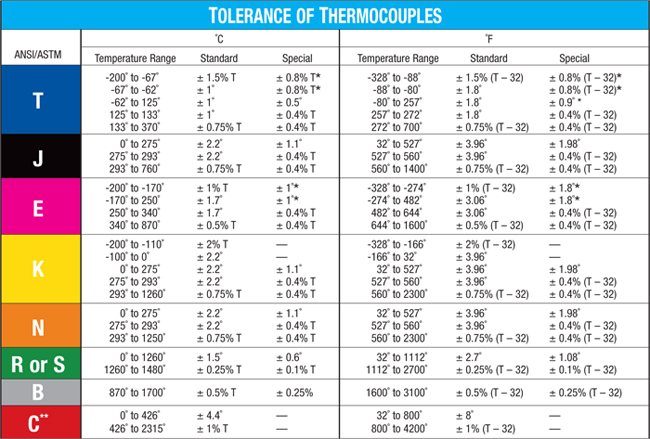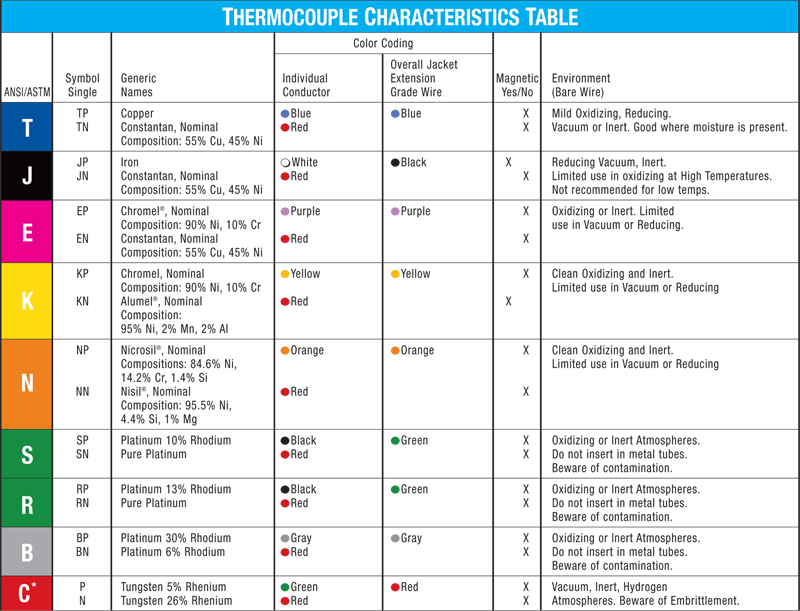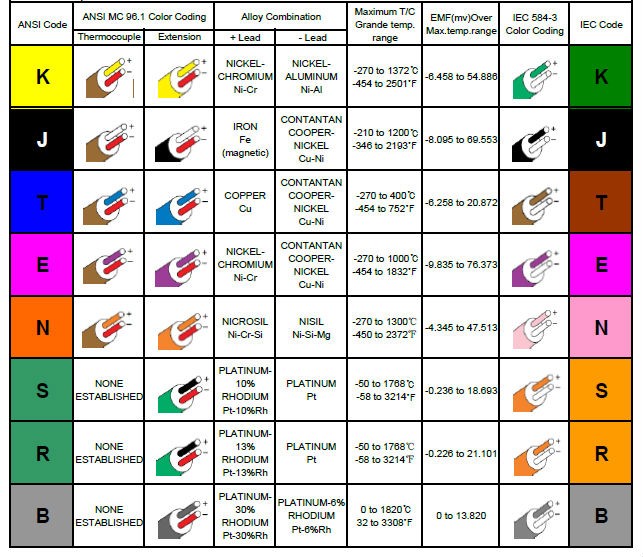It is found in other laboratory environments as well. Type R, S, and B thermocouples are “Noble Metal” thermocouples, which are used in high temperature applications (see thermocouple temperature ranges for details). These two metal wire legs are connected together at the end of the circuit to form a junction. So the temperature can be calculated at this junction. It’s inexpensive, accurate, reliable, and has a wide temperature range.

The type K is commonly found in nuclear applications because of its relative radiation hardness. Thermocouples are a widely used type of temperature sensor. The most widely recognized are the Base Metal thermocouples recognized as Types E, J, T, K as well N. Selecting thermocouple types Different types of thermocouples use various combinations of several metals resulting in a wide range of sensitivies, linearities, temperature ranges, and corrosion resistances. The temperature extremes and environment to which the bare thermocouple (TC) wires will be exposed are the starting points in the type.
It is simply a pair of wires of different composition, joined at one end. A thermocouple is a temperature sensor that uses a junction formed by dissimilar metals. Collecting data from a type K thermocouple. A Type K thermocouple can be connected to a voltmeter for simple data collection. In this case, the output is a voltage, and the reader has to convert the voltage level to temperature using a conversion formula.
The first widely used thermocouple type is the K type thermocouple. This is because the thermocouple type k is inexpensive and has a big temperature range. The therocouple K type is used in many applications.
Type R and S thermocouples are the most popular rare metal thermocouple types. They are very similar in conductor construction. The main difference is that Type R is more popular in the UK whereas Type S is more popular in Europe.
Seebeck EMF and temperature, physical characteristics and an assigned type letter designator and color code. Pyromation produces a wide range of thermocouples and thermocouple replacements for most market applications, including MgO (Magnesium Oxide), industrial and general-purpose types. ThermoWorks carries dozens of Type K thermocouple probes. Select from general purpose probes, high temperature probes, penetration probes, surface probes, wire probes, and thermocouple accessories. This sensor consists of two dissimilar metals, joined together at one end.
Temperature measurement and recording with the TC-is very easy — simply plug the TC-into a USB port on your computer, plug in your thermocouples, and you are ready to go. The two common types of connector are ‘standard’ with round pins and ‘miniature’ with flat pins. This causes some confusion as ‘miniature’ connectors are more popular than ‘standard’ types. When choosing a thermocouple , consideration should be given to the thermocouple type , insulation and probe construction. Type B voltage as a function of temperature is non-monotonic, with a minimum of -2.

V at a temperature of 21. We also manufacture custom RTDs and Thermowell styles to fit your application needs. Multipoint thermocouples are a specialty we offer.
Contact us today for more information about the thermocouples types we offer and pricing. This voltage is measured and used to determine the temperature of the heated metals. The voltage for any one temperature is unique to the combination of metals used. Type K is the most common thermocouple grade wire because it is affordable. The positive conductor is chromel, a chromium-nickel alloy, and alumel, a nickel-manganese-aluminium-silicon alloy.

Other types include N, S, R, B and C. Temperature is the most widely measured process variable and its measurement is critical in many manu-facturing processes. Also thermocouple type of instruments has greater accuracy in measuring the current and voltages at very high frequency accurately. Within a given thermocouple “ Type ,” (standardized pair of dissimilar materials), various levels of purity (and hence accuracy) can be purchased. Each type of thermocouple has a specified temperature range based on the properties of the metals used in creating that thermocouple.
RTDs offer a smaller temperature range in exchange for better linearity and accuracy, and thermistors provide the lowest temperature ranges but excellent sensitivity. The entire span of each thermocouple type is presented in a single range. Type K general purpose thermocouple kit and two multi-purpose kits with optional moulded on probes or hand held temperature probes, Catering Kit with High Accuracy Chef Thermometer and optional Type T probes, Legionella Kit with integral timer. Each thermocouple type has characteristics that can be matched to applications. Industry generally prefers K and N types because of their suitability to high temperatures, while others often prefer the T type due to its sensitivity, low cost and ease of use.
This sometimes makes one type better for a specific application than another. The most common types of temperature thermocouples are type j thermocouples and type k thermocouples. Advantages of thermocouple sensors include: low cost, small size, wider temperature ranges and faster response than RTDs. These two wires are joined to form a temperature measurement junction. Each wire is made of a specific metal or metal alloy.
On the settings tab, type in the minimum and maximum temperature values you expect to read from your thermocouple (to 1°C by default). Select your thermocouple type and CJC Source and CJC Value.
Hiç yorum yok:
Yorum Gönder
Not: Yalnızca bu blogun üyesi yorum gönderebilir.